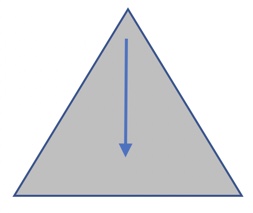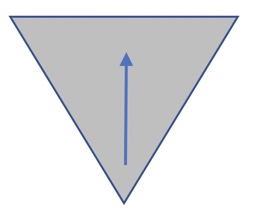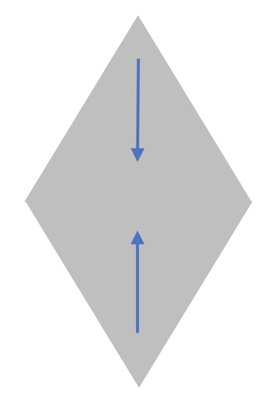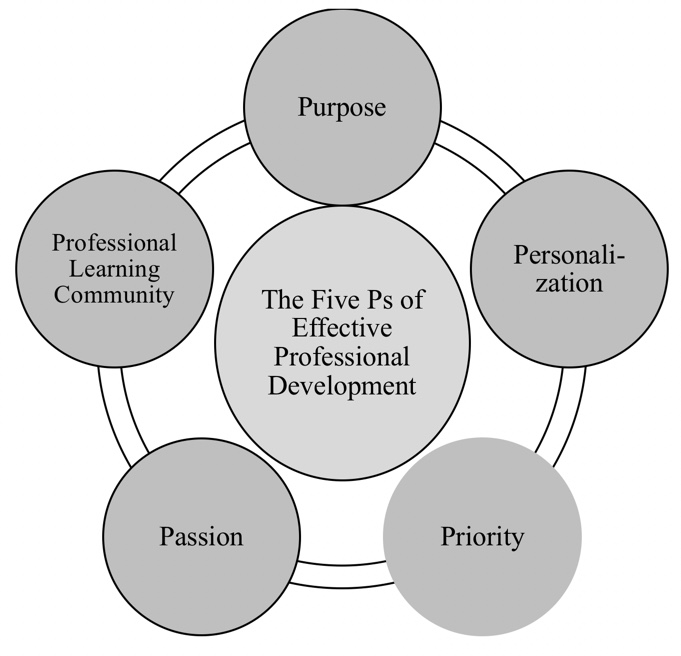Introduction
Within English language teaching (ELT), teacher professional development is a topic of interest and importance because it is within the interest of the profession to ensure that its members act according to the highest levels of agreed upon standards. When asked, most teachers express a desire to improve their teaching in order to improve student learning. In addition, institutions place a “high priority” (Richards, 2015, p. 703) on the professionalization of the teachers they employ. The importance of teacher professional development within ELT is emphasized by the inclusion of several entries in the recently published multi-volume encyclopedia The TESOL Encyclopedia of English Language Teaching (Park, 2018).
The purpose of this article is to summarize major findings about professional development within ELT and to present three models of development, with a clear recommendation of an integrated approach to teacher development in order to meet the needs of teachers as well as the schools in which they teach.
An early version of this information was presented at the MEXTESOL conference in Leon, Guanajuato, Mexico in November 2017.
Major Findings on ELT Professional Development
One of the roles of teacher professional development is to provide a context through which teachers can continue to make improvement and, as Richards (2015) points out, to assist in “maintaining the interest, creativity, and enthusiasm of teachers in their profession” (p. 695).
Second language teacher professionalism can be defined as a “selectively combined set of disciplinary-based knowledge, ethical principles, and time- and place-specific work practices” (Leung, 2009, p. 50). Teachers typically develop these four domains through pre-service training, within the context of formal university training. In-service training occurs while teachers are engaged in teaching related employment. Farrell (2012) effectively points out that there is a gap between the pre-service training that teachers receive while attending a university and the in-service training provided while employed as a teacher. He illustrates this point by suggesting that after completing university studies “most novice teachers suddenly have no further contact with their teacher educators and from the very first day on the job must face the same challenges as their more experienced colleagues, often without much guidance from the new school or institution” (p. 436). Thus, there is a great need for schools and educational institutions to identify ways that they can facilitate the on-going professional development of teachers, especially those who have recently graduated from university studies.
Ousseini (2018) indicates that “teacher professional development may seek to improve practitioners’ job performances, extend their experience for career development, promote job satisfaction, prepare them for change, enhance their views of the job they do, or improve their understanding of educational policy” (p. 1). Perhaps the reason that teaching professionals care about improving their development is so that students can increase in their learning. It is important to understand that development as a teaching professional is not a single event but rather a life-long process of learning and growing to improve the act of teaching.
Crandall and Finn Miller (2014) provide an excellent summary of five characteristics of effective teacher professional development. They indicate that effective teacher professional development
- “involves learning opportunities over an extended period of time,
- engages teachers in deepening and extending skills,
- challenges teachers’ assumptions about learning,
- involves teachers in talking with one another,
- has administrative support” (p. 632).
One possible characteristic of a strong ELT professional is one who possesses grit. In her seminal work on grit, Duckworth defines grit as a “ferocious determination,” (Duckworth, 2016, p. 8) that is demonstrated by individuals through resilience, hard work, passion and perseverance. She also emphasizes that a central aspect of grit is the effort that one invests. She indicates that effort counts twice! (p. 42). Look closely at the following information that illustrates what she means by effort counting twice.
talent x effort = skill
skill x effort = achievement
Duckworth (2016) emphasizes that gritty people are the ones that combine effort with talent that results in skill. They then combine effort with skill that results in achievement. "Without effort, your talent is nothing more than your unmet potential. Without effort, your skill is nothing more than what you could have done but didn't. With effort, talent becomes skill and, at the very same time, effort makes skill productive" (p. 51).
As I read this information for the first time, I started wondering how much effort do I put into my professional development as an ELT professional? Do I (over) rely on my talent as a teacher? Do I (over) rely on my skill as a teacher? If I add to my talent and my skill two measures of effort then I should be able to increase my performance as a teacher. These questions and issues have contributed to my interest in my own and other’s professional development within ELT.
Crandall and Finn Miller (2014) suggest that “the most effective professional development begins with your concerns and your classroom. Just as effective language lessons address the needs of learners, professional development for language teachers should be relevant to your particular needs. All teachers have unique attributes and areas of need related to their teaching practice.” (p. 631, italics added). Becoming an English language teacher means becoming part of a worldwide community of professionals with shared goals, values, discourse and practices, but one with a self-critical view of its own practices and a commitment to a transformative approach to its own role (Richards, 2015).
Three Models for Professional Development for Language Teachers
The concepts of top-down approaches to second language reading, bottom-up approaches, and interactive approaches should be familiar to most ELT professionals. I would like to use this same line of thinking to present three models of teacher professional development. As we consider each approach to teacher professional development, a key question to ask ourselves is who is preparing the professional development opportunity?
Top-Down Teacher Professional Development
A top-down approach to teacher professional development is provided by an institution or regulatory body determining what the teachers need in order to make improvements. Richards calls this an “expert driven process” (2015, p. 697). A top-down approach to teacher development assumes that the school is the primary source of professional development and the focus is on meeting the needs of the institution and not necessarily the needs of the teachers.
Figure 1 provides a visual representation of a top-down approach by an inverted triangle.

Figure 1: A visual representation of a top-down model of teacher professional development.
Richards (2015) points out that “from an institutional perspective, professional development opportunities . . . are intended to improve performance of teachers as well as benefit the school as a whole” (p. 703). He continues by emphasizing that it is the school’s role to “provide the means by which teachers can acquire the knowledge and skills they need” (p. 702).
Crandall and Finn Miller (2014) indicate that the traditional format for teacher professional development involved the institution determining what teachers needed and then providing “a mandatory in-service workshop . . . with little input from teachers” (p. 631). This is a classic example of a top-down approach to teacher professional development. In response to the question, who is preparing the professional development opportunity, it is the institution that determines the needs and then provides the development of the teachers to fulfill the need.
One challenge with a top-down approach to teacher professional development is that the actual needs of individual teachers may be overshadowed by what administrators perceive as the greater needs of the institution.
Bottom-Up Teacher Professional Development
A bottom-up approach to teacher professional development is an approach that is directed and guided 100% by an individual teacher. The teacher decides the approach he/she want to take to his/her own PD. This approach is likely to only be successful for highly motivated teachers who have a system in place to hold themselves accountable for their development.
Figure 2 provides a visual representation of a bottom-down approach by a triangle.

Figure 2: A visual representation of a bottom-down model of teacher professional development.
Richards (2015) outlines eight strategies for personal professional development: (1) find out how you teach, (2) expand your understanding of language teaching, (3) expand your teaching skills, (4) review and reflect on your own teaching, (5) collaborate with other teachers, (6) arrange for peer observation, (7) document your own teaching, and (8) research your own classes. Notice that with each of these eight strategies, it is the teacher who is making the decisions about their own professional development. It is clear then as we respond to the question of who is preparing the professional development opportunity, that it is the teacher who had complete control of the development process.
Interactive Teacher Professional Development
As with models of L2 reading development, an interactive approach to teacher professional development is likely to be the most effective. This approach draws up both input from employers and institutional needs analyses as well as from individual teachers who have identified their own professional development needs.
Figure 3 provides a visual representation of an interactive approach to teacher PD with the combination of the inverted triangle and the triangle.

Figure 3: A visual representation of an interactive approach to teacher professional development.
the institution’s goals and the teacher’s own goals” (p. 706) that it is more effective in bringing about the transformative change that is desired for both institutions and individuals.
Crandall and Finn Miller (2014) emphasize that based on key research studies on teacher professional development, “sustained, content-focused professional development was most effective when it actively involved teachers in concrete ways and concentrated on specific instructional practices rather abstract discussions of teaching” (pp. 631-632). This emphasizes why an interactive approach to teacher professional development may be the best approach. Both the institution and teachers should be collaborative in the ways that professional development training is identified and how teachers are held accountable for their development to improve their teaching and ultimately the learning of their students.
From the position of an institution, Richards (2015) identifies five steps for the implementation of an effective professional development program. The steps include: (1) determine the needs of both the institution and its teachers, (2) set goals for professional development, (3) select the participants, (4) provide support, and (5) evaluate what has been learned.
In an effort to assist English language teaching institutions in designing appropriate teacher development programs, I provide five principles as a framework to strengthening teacher professional development within an interactive approach. I name this framework the five Ps of effective professional development.
The five Ps include: purpose, personalization, priority, passion, and professional learning community. Figure 4 provides a visual representation of the five Ps.
The value of using the five Ps as a foundation for an interactive approach to teacher professional development is that from both an institutional perspective and an individual teacher perspective, the needs of both are better met.

Figure 4: The five Ps of effective professional development.
Purpose
The first P focuses on the purpose of the professional development. From both the institution and the individual teacher perspective, there should have a very clear purpose that establishes the need for professional development. Returning to Duckworth’s (2016) work on grit, she has found that
At its core, the idea of purpose is the idea that what we do matters to people other than ourselves. . . . Purposemeans the intention to contribute to the well-being of others. . . . Grittier people are dramaticallymore motivated than others to seek a meaningful, other-centered life. Higher scores on purpose correlate with higherscores on the Grit Scale. (Duckworth, 2016, pp. 145-147)
From an institutional perspective, purpose is best achieved through an organizational mission statement. The TESOL International Association provides a Leadership Development Certificate Program (LMCP) that can assist program leaders in learning the basic principles involved in the creation or updating of a mission statement. The LMCP course is available online as well as through face-to-face sessions presented annually at the TESOL International Association Convention. For more information please see visit the TESOL International Association website at http://www.tesol.org/attend-and-learn/certificate-leadership-programs/elt-leadership-management-certificate-program .
A statement of purpose will make clear to everyone that reads it the rationale for teacher professional development.
Personalization
The second P focuses on personalization of the professional development. Particularly when addressing professional development from the perspective of an individual teacher, personalization is central to achieving one’s goals. Professional development must be centered on teachers’ needs for their own development. This is the primary reason why an interactive approach to professional development is vital to the success of any institution. Language programs can only do so much in terms of determining what individual teachers need. When a teacher personalizes his/her own professional development needs then much more success will result.
Fink (2013) emphasizes the importance of personalization by highlighting the role of learning about ourselves as educators. He points out that
[w]hen we learn about our self, we might learn something that helps us understand who we are at the present time; this kind of learning changes or informs our self-image. At other times, we might learn something new about the person we want to become; this gives us a new self-ideal. Both are important and either may happen intentionally or as a by-product of the formal aspects of our education. (Fink, 2013, p. 51)
I want to emphasize the importance of intentionality in our processes of personalizing our professional development in terms of improving our self-image and our self-ideal. Individuals know best what they need to improve in order to meet the needs of learners in their classrooms. By personalizing our professional development needs, teachers will be much more successful. We cannot hope that personalization will happen. We need to build in some measure of intentionality. Institutions can facilitate opportunities for teachers to reflect upon their needs and identify ways that the institution can support development. In this way, the interactive approach is most effective.
Individual teachers can take action by reviewing the following questions:
What do I see as my core purpose as an ELT professional?
Why do I want to be a better English language teacher?
Am I the best ELT professional I can be?
Am I actively contributing to building the best ELT program at my institution?
What changes do I need to make to be my best self?
The answers to these questions can lead to the identification of specific needs that can be fulfilled through professional development.
Priority
The third P focuses on priority of the professional development. When individuals begin identifying purpose and personalizing their professional development, one tendency is to become overwhelmed by so many things that could be done to make improvements as a teacher. When one is overwhelmed one result is often to do nothing to improve because there is too much to improve. Therefore, teachers need to prioritize the list of areas in which they could develop and limit their focus to a single item at a time.
Teachers can take action to prioritize by first making a list of possible professional development priorities and then prioritizing that list to one issue that can be focused on for an extended period of time. The key is to not become overwhelmed by all of the things that you could do as part of your professional development, but instead ask yourself, what is one priority that you could identify to work on now?
Passion
The fourth P focuses on passion for professional development. Passion is what drives us to accomplishing our goals. If we want passionate learners we must have passionate teachers. We know that “[s]tudent motivation is related to the teacher’s motivational practice” (Guilloteaux & Dörnyei, 2008, pp. 72-73), therefore we want to make sure that in our development as teachers that we are passionate about what we are doing to develop ourselves to become better teachers.
Perhaps the central question that teachers can focus on to accomplish their professional development goal is to ask, do I have the passion to work on one single item that I have identified to improve myself as an ELT professional? If we allow our passion to drive us forward, we want to make sure that our passion is focused on the single area of focus that we have for our professional development.
Professional Learning Communities
The final P focuses on professional learning communities. Learning and teaching can be social processes. As we interact with others in the process of our own professional development as teachers, we have others who can help hold us accountable.
Crandall and Finn Miller (2014) point out that “[t]he research evidence suggests that educational institutions that align their performance goals to teachers’ professional development through professional learning communities (i.e., groups of teachers who meet regularly to plan, problem solve, and learn together) achieve positive outcomes” (p. 632). This research strengthens the role for institutions and individual teachers to establish a professional learning community.
Individual teachers can take action by asking the following questions:
How can I take responsibility for my own professional development and create a professional learning community with my trusted colleagues?
How can my colleagues and I share what we are learning about our practice as classroom teachers that will continue to improve our teaching and the learning of our students?
Develop a Personal Professional Development Plan (PPDP)
Everything addressed in this article leads to the development of a Personal Professional Development Plan (PPDP). I emphasize personal in the PD plan because I believe that teachers need to be held accountable for the development of their own plan. Once a PPDP is in place then the institution can identify ways to support teachers as they accomplish their individual goals.
A PPDP can include each of the five Ps. Teachers can ask
- What is the purpose of my PD as an ELT professional?
- What are my personalized needs for PD?
- Given everything that I could focus on in my PD, what is one priority that I will work on now?
- What will I do to maintain my passion to accomplish my PD goal?
- What can I do to build a professional learning community to support me as I work towards accomplishing my PD goal?
Richards (2015) highlights that “institutions that recognize the benefits of professional-development opportunities for their teachers should adopt a strategic approach to such activities and provide the necessary conditions and support for them to be realized” (p. 724). By having teachers complete a PPDP, the responses to the questions can then be strategically used by the institution to outline possible professional development events to meet the needs of both the teachers and the institution.
Additional Resources for Consideration
The TESOL International Association annually provides 50 professional development scholarships to individual teachers to fund convention registration and the fee for one Pre- or Post-Convention Institute. The application deadline is typically November 1 of each year. Teachers who have not yet had the opportunity to attend a TESOL International Association annual convention should consider the benefits of applying for a professional development scholarship.
Conclusions
This article summarized major findings about professional development within ELT and to presented three approaches to ELT professional development: (1) a top-down approach where a school or institution determines the professional development needs then provides training to fill those needs, (2) a bottom-up approach that is driven completely by a teacher him/herself, and (3) an interactive approach where the institution and the teachers collaborate with each other in identifying needs of both and then providing professional development opportunities to meet the identified needs. I then provided five principles as a framework for strengthening teacher professional development within an interactive approach—the five Ps of effective professional development: purpose, personalization, priority, passion, and professional learning community.
It is to the advantage of both the institution and the individual to collaborate in an interactive approach to professional development so that institutional needs are met, individual teacher needs are met, and, most importantly, classroom instruction improves so that ultimately student learning improves through greater increases in English language proficiency.
My hope is that institutions and teachers can use the ideas presented here to make the appropriate adjustments so that there is a significant improvement in English language teaching. I invite programs who use this model to contact me with success stories as well as stories of continued challenges as we all work towards improving English language teaching and learning around the world.
References
Crandall, J. & Finn Miller, S. (2014). Effective professional development for language teachers. In M. Celce-Murcia, D. M. Brinton, & M. A. Snow (Eds.). Teaching English as a second or foreign language (4th ed., pp. 630-648). Boston, MA: National Geographic Learning/Cengage Learning.
Duckworth, A. (2016). Grit: The power of passion and perseverance. New York, NY: Scribner.
Farrell, T. S. C. (2012). Novice-service language teacher development: Bridging the gap between preservice and in-service education and development. TESOL Quarterly, 46, pp. 435-449. doi:10.1002/tesq.36
Fink, L. D. (2013). Creating significant learning experiences: An integrated approach to designing college courses. San Francisco, CA: Jossey-Bass.
Guilloteaux, M. J., & Dornyei, Z. ( 2008). Motivating language learners: A classroom-oriented investigation of the effects of motivational strategies on student motivation. TESOL Quarterly, 42, 55-77.https://doi.org/10.1002/j.1545-7249.2008.tb00207.x
Leung, C. (2009). Second language teacher professionalism. In A. Burns and J. C. Richards (Eds.), The Cambridge guide to second language teacher education (pp. 49-58). New York, NY: Cambridge University Press.
Ousseini, H. (2018). PD for NEST/NNEST ELT teachers in the EFL setting. In G. Park (Ed.), The TESOL Encyclopedia of English Language Teaching, Teacher Training and Professional Development (1st ed.). Edited by John I. Liontas (Project Editor: Margo DelliCarpini) Hoboken, NJ: John Wiley & Sons, Inc. Retrieved from https://onlinelibrary.wiley.com/doi/full/10.1002/9781118784235.eelt0879.
Park, G. (2018). (Ed.). The TESOL Encyclopedia of English Language Teaching, Teacher Training and Professional Development (1st ed.). Edited by John I. Liontas (Project Editor: Margo DelliCarpini) Hoboken, NJ: John Wiley & Sons, Inc.
Richards, J. C. (2015). Key issues in language teaching. New York, NY: Cambridge University Press.

